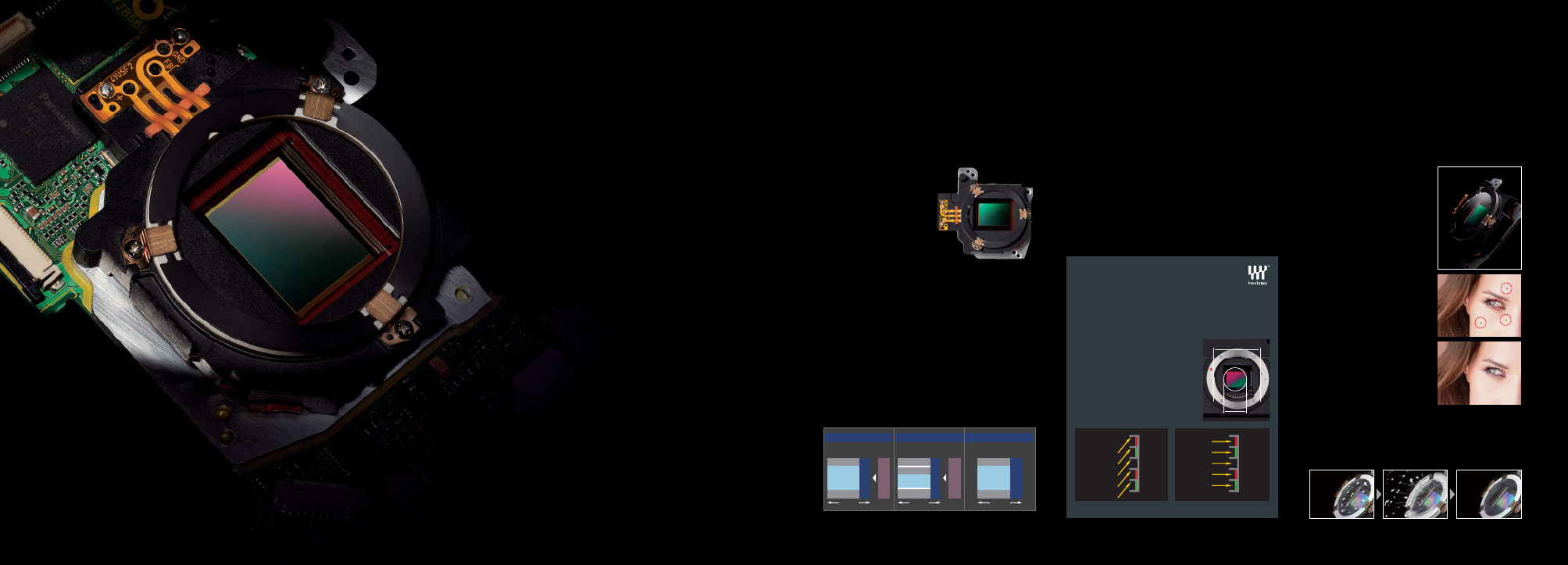
Beautiful High-Resolution Images: 7.5-Megapixel 4/3-type Live MOS Sensor for the Best of Both CMOS and CCD Sensors
The L1 uses a high-image-
quality 7.5-megapixel 4/3-type
Live MOS sensor. The ideal
sensor for digital SLR cameras,
the Live MOS sensor delivers
the same high image quality as
a CCD sensor with the low
power consumption of a CMOS
sensor. This advanced sensor draws on MOS signal amplification
technology but uses a simpler structure. It's molded as a single
unit onto a flexible circuit board, reducing both the number of
signal exchanges and the contact resistance from wiring. A
process technology with 5-V activation reduces heat and noise
while improving the image quality of the Live View function.
The Live MOS sensor featured in the L1 uses a new readout
circuit that reduces the three control wirings required with a
CMOS sensor to the two wirings required with a CCD sensor.
This provides a greater photoreceptive area per pixel than a
conventional CMOS sensor can provide. The result is the type of
wide dynamic range that makes it possible to capture detailed,
expressive images with rich gradation.
The Birth of Beauty
The Rich Tonal Quality of the CCD,
the Low Power Consumption of CMOS
The Live MOS sensor not only slashes noise, it embeds the
photodiodes deeply into the silicon layer, where they are
resistant to noise generated on the photodiode surface. This
suppresses the rough image texture that is sometimes
noticeable (like viewing an image through an unwashed
window) when shooting in dim lighting, giving you clear,
smooth shots even in difficult conditions.
Low-Noise Processing and Pinned Photodiode Array
Reduce Image Graininess
A Wide Dynamic Range for Richer Image Gradation
Protecting the Digital SLR Image Sensor:
Dust Reduction System
One of the risks with a digital SLR
camera is that, during a lens
change, dust or dirt could make its
way into the camera and adhere to
the image sensor. This would show
up as a flaw in the same location of
every photo you shoot. Even worse,
the foreign matter could damage
the image sensor. The only remedy
would be to have the image sensor
replaced – a costly undertaking.
The L1 solves this problem with a
supersonic wave Dust Reduction
System. Each time the camera is
turned on, a filter positioned
between the low pass filter and
shutter vibrates around 30,000
times a second to shake away dust
or dirt. The loosened dust is
collected by a dust adhesion
section located under the filter.
Because the area between sensor
and filter is completely airtight, no dust adheres to the low
pass filter or image sensor. This advanced supersonic wave
filter requires no maintenance. If you use a digital SLR camera
with interchangeable lenses, this kind of advanced protection
against dust is absolutely essential.
The Four Thirds Standard:
Designed to Maximize Image Quality
in Digital Cameras
Lens mount diameter
Image circle diameter
Light rays
(Image)
Image
sensor
Light rays
(Image)
Image
sensor
For accurate imaging, the light must strike the image
sensor at a perpendicular angle. When a lens designed for
a film camera is used, light from the edge of the image
area enters at an angle, resulting in
inaccurate color reproduction or
dark areas. The L1 uses a lens
mount with about twice the diameter
of the image circle. Light strikes the
sensor at an almost perpendicular
angle, so images are clear and
accurate all the way to the edges.
Film camera lens design FourThirds System lens design
0908
Comparison of Light Receiving Areas per Pixel (Panasonic figures)
Live MOS Sensor
Light receiving area rate 50%
CMOS
Light receiving area rate 35%
5.6 µm
CCD
Light receiving area rate 50%
Circuit section
New
drive circuit
5.6 µm
Wiring-2
Wiring-1
Light receiving
area
5.6 µm
Data transfer
section
Circuit section
Wiring-2
Wiring-3
Wiring-1
Light receiving
area
Conventional
drive circuit
Wiring-2
Wiring-1
Light receiving
area










